This article needs additional citations for verification .(June 2019) |

The Wawelbergs were a Polish Jewish family whose banking house was active in both Congress Poland and the Russian Empire.
This article needs additional citations for verification .(June 2019) |

The Wawelbergs were a Polish Jewish family whose banking house was active in both Congress Poland and the Russian Empire.

The Russian branch was founded by Hyppolite Wawelberg (1843–1901). The first Wawelberg Bank had its origins in a loan office that began operating in the early 1840s. In 1869 young Hyppolite Wawelberg moved to St. Petersburg where he launched a new venture, the Wawelberg Bank. Hyppolite Wawelberg's Polish-Jewish connections (Wawelbergs were Jewish) remained strong, and the bank was generally known as having two separate centers - in Warsaw and in St. Petersburg. The first location of Wawelberg Bank was 25 Nevsky Prospekt in St. Petersburg (House of the Parish of Our Lady of Kazan Cathedral, now housing Stockmann department store and SAS - Scandinavian Airlines System offices). Hyppolite Wawelberg made a fortune in Russia though he was equally well known as a generous philanthropist.
The new Polish Kingdom (Polish : Królestwo Polskie; Russian : Korolevstvo Polskoe), as created by the Congress of Vienna, was a Polish entity but was in personal dynastic union with Imperial Russia, since the reigning Romanov Tsar was also king of Poland. Though based in St. Petersburg, the Wawelbergs were instrumental to the development of finance in the Polish Kingdom. They were to Congress Poland what the Medicis were to Florence, the Fuggers to Augsburg, the Rothschilds to France, and the Mellons to the late-19th-century United States.
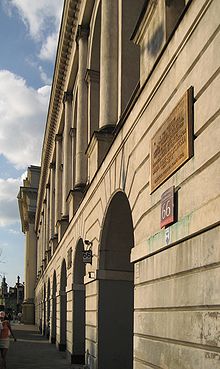
By 1900 Hyppolite Wawelberg was at the helm of the Wawelberg Bank and held the title of honorable citizen of St. Petersburg, an appellation that could be passed on like a title of nobility. He was also a member of the management board of the Warsaw Bank of Commerce (Bank Handlowy w Warszawie). Back in St. Petersburg he was a member of the treasury of the Jewish Colonist Society, honorable member of the Jewish Educational Society (Общество распространения просвещения среди евреев) and benefactor of the Roman Catholic Beneficial Society (Римско-католического благотворительное общества).
In 1875, in Warsaw, Poland, Hyppolite Wawelberg co-founded the Museum of Industry and Agriculture (Muzeum Przemysłu i Rolnictwa w Warszawie). It was in a physics laboratory there that, in 1890–91, Maria Skłodowska (Marie Curie), future investigator of radioactivity and future double Nobel laureate, did her first scientific work.
In 1895 Hyppolite Wawelberg founded the Warsaw Mechanical-Technical School with his faithful friend and collaborator, Stanislav Rotwand (Cтанислав Ротванд, Stanisław Rotwand), an 1860 alumnus of the University of Saint Petersburg law school.

Michael Wawelberg (Михаил Ипполитович Вавельберг; 1880 – after 1929) received a classical educational at the St. Nicholas Imperial Gymnasium in Tsarskoe Selo (Царскосельская Императорская Николаевская гимназия), from which he graduated in 1899. His father Hyppolite Wawelberg donated 500 roubles for the gymnasium's own charity, which at the time was a considerable sum of money.
in 1903 Michael Wawelberg graduated from the University of St. Petersburg law school. That year he also took over the management of the Wawelberg Bank, which in 1912 was renamed the St. Petersburg Commercial Bank (Петербургский Торговый банк). In 1913 a branch was founded in Poland and became a publicly traded company – the Western Bank (Bank Zachodni) in Poland). The Wawelbergs later lost control of it due to Russian Bolshevik-induced turmoil.
In 1910 the St. Petersburg Commercial Bank purchased a building with a lot underneath it[ clarification needed ] in one most prestigious locations, at the corner of Nevsky Prospekt and aristocratic Malaia Morskaia ulitsa (7 and 9 Nevsky Prospekt ). The bank announced an open competition for the building's design. The competition was won by young Russian architect Marian Peretiatkovich (Peretyatkovich).
Naom Sindalovskii quotes a telling local St. Petersburg legend about building's construction. According to the legend after the building was constructed and the client (Michael Wawelberg) inspected it and could not find any deficiency with the work, he ordered to change the doors anyway because the door sign said "push." That's not what I do in life, said Wawelberg, I only pull things toward myself.
In 1917, on the eve of the Bolshevik putsch, Michael Wawelberg lived in Tsarskoye Selo at 66 Boulvardnaia ulitsa (66 Boulevard Street; ул. Бульварая, 66; Soviet name: Октябрьский бульвар, Oktiabr'skii Boulevard). He was the chairman of the Commercial Bank and director of the board of Donetsk and Grushev Coal and Anthracite Mines (директор правления Донецко-Грушевского акционерного общества каменно-угольных и антрацитовых копий).
He fled Russia after 1917 and then disappears from the public view. Most likely he settled in Poland or spent some time there, because in Andrei Serkov's book on Russian Free Masonry he mentions that two free masons, Alexander Erdman and Michael Wawelberg (М. И. Вавельберг), as they considered themselves Russian, petitioned Grand Master of the Polish Lodge with a request to allow them to found the Russian Lodge in Warsaw.
In St. Petersburg the Wawelbergs are best remembered because of the Wawelberg Bank building still popularly known as the House of Wawelberg (Дом Вавельберга) at 7/9 Nevsky Prospekt.
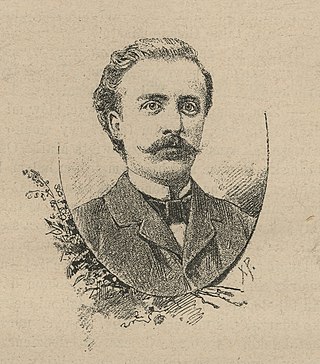
Józef Jerzy Boguski was a Polish chemist and a professor at the Warsaw Polytechnic.

Nevsky Prospect is a main street located in the federal city of St. Petersburg in Russia. Its name comes from the Alexander Nevsky Lavra, the monastery which stands at the eastern end of the street, and which commemorates the Russian hero Prince Saint Alexander Nevsky (1221–1263). Following his founding of Saint Petersburg in 1703, Tsar Peter I planned the course of the street as the beginning of the road to Novgorod and Moscow. The avenue runs from the Admiralty in the west to the Moscow Railway Station and, after veering slightly southwards at Vosstaniya Square, to the Alexander Nevsky Lavra.

Palace Square, connecting Nevsky Prospekt with Palace Bridge leading to Vasilievsky Island, is the central city square of St Petersburg and of the former Russian Empire. Many significant events took place there, including the Bloody Sunday massacre and parts of the October Revolution of 1917. Between 1918 and 1944, it was known as Uritsky Square, in memory of the assassinated leader of the city's Cheka branch, Moisei Uritsky.

Vosstaniya Square, before 1918 Znamenskaya Square, is a major square in the Central Business District of Saint Petersburg, Russia. The square lies at the crossing of Nevsky Prospekt, Ligovsky Prospekt, Vosstaniya Street and Goncharnaya Street, in front of the Moskovsky Rail Terminal, which is the northern terminus of the line connecting the city with Moscow. Administratively, the Vosstaniya Square falls under the authority of the Tsentralny District.

Elisseeff Emporium in St. Petersburg is a large retail and entertainment complex, including a famous food hall, constructed in 1902–1903 for the Elisseeff Brothers. Located at 56 Nevsky Prospekt, the complex consists of three buildings, although the corner one is the structure that is referred to as Elisseeff's store or shop. Designed by architect Gabriel Baranovskii, it is one of the most striking examples of St. Petersburg Art Nouveau architecture, although at the time of its construction the building was considered controversial.
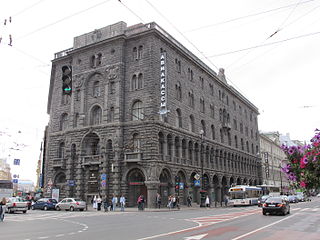
The Wawelberg Bank Building in St. Petersburg, Russia was built by the Wawelbergs - a prominent Polish banking family active in the Russian Empire. Although this building bears initials HW, it was commissioned by his son, Michael Wawelberg.
Hipolit Wawelberg (1843–1901) was a Polish Jewish banker, and one of the most prominent members of the Wawelberg banking family. He was a known for his involvement in Jewish affairs and culture.
Michael Wawelberg was a Polish-Russian Jewish banker, one of the best known members of the Wawelberg banking family.

The Catholic Church of St Catherine in St. Petersburg is the oldest Catholic church in the Russian Federation, and the only church with the title of basilica. It is located on the Nevsky Prospekt and is a part of the Archdiocese of Moscow headed by Msgr. Paolo Pezzi.

John Alexandrovich Kochurov, hieromartyr of the Soviet revolution, was one of a number of young educated priests who came to the United States in the late 1890s as missionaries among the émigrés from Carpathian Ruthenia and Galicia. He was active in establishing parishes and aiding communities, mainly in the Midwest. After returning to Russia he was assigned to Estonia where he put into action the teaching skills he learned in America before he was assigned in 1916 to Tsarskoe Selo. Here he was killed during the early days of the Bolshevik revolution. His feast day is celebrated on October 31. He is also commemorated on the Synaxis of the first martyrs of the American lands on December 12 and on the feast of the New Martyrs and Confessors of Russia, celebrated on the Sunday nearest to January 25, which was the date of the martyrdom of Metropolitan Vladimir of Kiev, the first of the new martyrs.

Vasily Vasilyevich Kozlov was a Soviet sculptor.

The Evangelical Lutheran Church of Saint Mary is an Evangelical Lutheran church located in Saint Petersburg, Russia. It was built in 1805 and refurbished in 2002. Its address is: Bolshaya Konyushennnaya Ulitsa 8A, off Nevsky Prospekt. It is usually called the Finnish church and is one of the oldest and largest Protestant churches in Russia.

The Evangelical Lutheran Church of Saint Catherine is an Evangelical Lutheran church located at Malaya Konyushnaya Ulitsa 1 in Saint Petersburg, Russia. The building was built in 1885. As it was built by and for Swedish expatriates in Saint Petersburg, it is usually called the Swedish church. The adjacent building is occupied by the Swedish General Consulate.
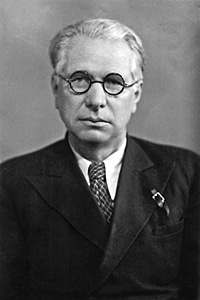
Rudolf Rudolfovich Frentz was a Soviet and Russian painter, watercolorist, graphic artist, illustrator and art teacher who lived and worked in Leningrad. He was a member of the Leningrad Union of Artists and one of the founders of the Leningrad school of painting, most famous for his battle and monumental painting.
The Rusluie were a community of Dutch origin living in the city of Saint Petersburg in Russia, between 1720 and 1917. They originally came from the town of Vriezenveen, in the Dutch province of Overijssel.
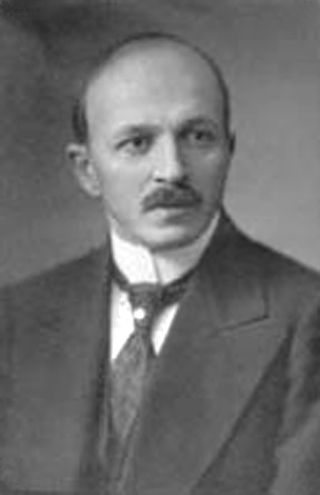
Marian Lutosławski was a Polish mechanical engineer and inventor born during the foreign partitions of Poland. He studied at the Technical University in Riga, then also part of Russia, and obtained a diploma in electrical engineering from the Technical University of Darmstadt in Germany. Lutosławski installed the first power station in a residential neighbourhood in Warsaw, and introduced new techniques such as the three-phase current. In 1900 he built the country's first power plant fueled by a diesel internal combustion engine for Hotel Bristol, Warsaw. He also designed the first two reinforced concrete bridges in Lublin in 1908 and 1909. Lutosławski was arrested in 1918 by the Bolsheviks, and was executed without trial near Moscow as a "counterrevolutionary".
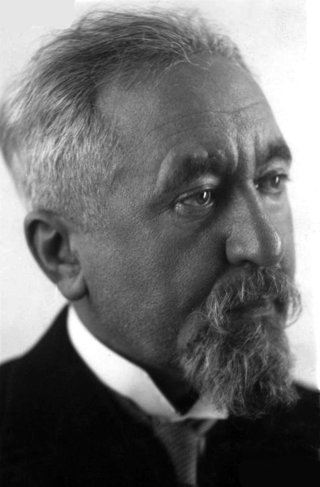
Jakub Mortkowicz was a Polish book publisher and bookseller.

Saint Petersburg – second-largest city in Russia. An important Russian port on the Baltic Sea, it has the status of a federal subject. Its name was changed to "Petrograd" in 1914, then to "Leningrad" in 1924, and back to Saint Petersburg in 1991.

Samuel Adalberg was a Polish historian of folklore, literature, a paremiologist and a state official. He is remembered for editing and publishing the first modern book on Polish proverbs.
Stepan Samoilovich Krichinsky was a Russian architect of the eclectic and modern era.